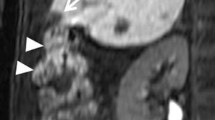Abstract
A high-efficiency hepatic cryosurgical unit has been developed and evaluated. It is capable of simultaneously driving three implantable insulated cryoneedle probes. The system has been used to treat 18 patients with secondary and 4 patients with primary liver cancer: open (n=12), total laparoscopic (n=6), laparoscopic assisted (n=4). In three patient laparoscopic cryotherapy was repeated inside 6 months.
Intraoperative bleeding was encountered in three patients undergoing high-volume hepatic freezing but the bleeding was easily controlled. A fall in the core body temperature was encountered in 10 out of 22 patients and averaged 0.4°;C. There was one postoperative death from liver failure in an 80-year-old patient in whom a large hepatoma was frozen. The most consistent postoperative biochemical change was hyperbilirubinaemia (n=3). A right-sided pleural effusion developed in two patients after freezing of lesions on the superior surface of the right lobe.
A survival benefit was encountered in three patients, one with central cholangiocarcinoma and the other two with large solitary secondary deposits (melanoma, colon cancer). Seven patients with multiple metastases and two patients with large hepatomas developed recurrence at the frozen site or elsewhere in the liver inside 12 months of follow-up and no clinical benefit could be demonstrated by cryotherapy in this group. In nine patients, the follow-up has been too short (<18 months) to permit any conclusion on outcome. The current limitations of hepatic cryotherapy are largely due to incomplete tumor destruction. The use of insulated laparoscopic cryoprobes which can be positioned under visual control through the parietes in the optimal site for maximal tumor ablation should enhance the therapeutic efficiency of cryotherapy for both primary and secondary hepatic tumors.
Similar content being viewed by others
References
Blackwood J, Moore FT, Pace WG (1967) Cryotherapy for malignant tumours. Cryobiology 4: 33–38
Charnley RM, Doiran J, Morris DL (1989) Cryotherapy for liver metastases: a new approach. Br J Surg 76: 1040–1041
Gill W, Fraser J, Carter DC (1968) Repeated freeze-thaw cycles in cryosurgery. Nature 219: 410–413
Healey WV, Priebe CJ Jr, Farrer SM, Phillips LL (197) Hepatic cryosurgery. Arch Surg 103: 384–392
Jacob G, Li AK, Hobbs KEA (1984) A comparison of cryodestruction with excision or infarction of an implanted tumour in rat liver. Cryobiology 21: 148–156
Miya K, Saji B, Morita T (1986) Immunological response of regional lymph nodes after tumour cryosurgery: experimental study in rats. Cryobiology 23: 290–295
Neel HB, Ketcham AS, Hammon WG (1971) Ischemia potentiating cryosurgery of primate liver. Ann Surg 174:309–318
Onik G, Kane R, Steele G, McDermott W, et al. (1986) Monitoring hepatic cryosurgery with sonography. AJR Am J Roentgenol 147: 665–669
Onik G, Rubinsky B, Zemel R, Weaver L, et al. (1991) Ultrasound-guided hepatic cryosurgery in the treatment of metastatic colon carcinoma. Preliminary results. Cancer 67: 901–907
Ravikumar TS, Kane R, Cady B, Jenkins RL, et al. (1987) Hepatic cryosurgery with intraoperative ultrasound monitoring for metastatic colon carcinoma. Arch Surg 122: 403–409
Ravikumar S, Steele G Jr, Kane R, King V (1991) Experimental and clinical observations on hepatic cryotherapy for colorectal metastases. Cancer Res 51:6323–6327
Ravikumar TS, Kane R, Cady B, Jenkins R, Clouse M, Steele G Jr (1991) A 5-year study of cryosurgery in the treatment of liver tumours. Arch Surg 126: 1520–1524
Rubinsky B, Lee CY, Bastacky J, Onik G (1990) The process of freezing and the mechanism of damage during hepatic cryosurgery. Cryobiology 27: 85–97
Shulman S, Brandt EJ, Yantomo C (1968) Studies in cryoimmunology: II. Tissue and species specificity of the autoantibody response and comparison with iso-immunization. Immunology 14: 149–158
Shulman S (1969) Cryosurgery and autoimmunization. J Cryosurgery 2: 84
Whittaker DK (1984) Mechanisms of tissue destruction following cryosurgery. Ann R Coll Surg Engl 66:313–318
Zhou X-D, Tang Z-Y, Yu Y-Q, Ma Z-C (1988) Clinical evaluation of cryosurgery in the treatment of primary liver cancer. Cancer 61:1889–1892
Author information
Authors and Affiliations
Rights and permissions
About this article
Cite this article
Cuschieri, A., Crosthwaite, G., Shimi, S. et al. Hepatic cryotherapy for liver tumors. Surg Endosc 9, 483–489 (1995). https://doi.org/10.1007/BF00206832
Received:
Accepted:
Issue Date:
DOI: https://doi.org/10.1007/BF00206832




